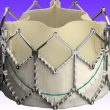Prosthesis mismatch (PPM) was introduced by Rahimtoola in 1978 and happens when the effective orifice area of a heart valve prosthesis is too small in relation to patient body size. Surgical valves have been well documented, but there is little information on percutaneous valves. The study looked at 757 patients undergoing TAVR with pre and post procedural eco-Doppler...
Europe Grants Approval to Balloon-Expandable Valve in Low-Risk Patients; Self-Expanding Valve Still Waiting for It
The balloon-expandable valve has been granted approval in Europe for treatment of the complete risk spectrum of symptomatic severe aortic stenosis. Europe has recently approved an expanded indication for the Sapien 3 system for use in low-risk patients, as reported by Edward Lifesciences. Sapien 3, which includes the next-generation Sapien 3 Ultra, is the first transcatheter heart valve...
Prosthesis Mismatch in Supra and Intra Annular valves
The self-expandable valve was associated to lower prosthesis-patient mismatch (PPM) compared against the balloon expandable valve regardless annular area, according to this study soon to be published in J Am Coll Cardiol Intv. This difference was basically driven by patients with larger body surface area (>1.83m²). Prosthesis mismatch has been associated to increased mortality after transcatheter...
FDA Expands TAVR Indication to Low-Risk Patients
Both the self-expandable valve Evolut R and its direct competitor, balloon-expandable valve Sapien 3, received the authorization to be indicated for low-risk patients in a long-awaited announcement made on August 16th, 2019. The US Food and Drug Administration (FDA) has approved and expanded the indication for the Evolut series (Medtronic) and the Sapien 3 and...
Valve-in-Valve with Self-Expanding Prosthesis: What Happens with Gradients at One Year?
Degenerated surgical bioprostheses can be safely treated with CoreValve or CoreValve Evolut using the valve-in-valve procedure. Excellent 1-year clinical and hemodynamic outcomes were achieved in a non-selected regular population, i.e., “real-world” patients. The VIVA (Valve in Valve) registry, conducted at 23 sites, was a prospective study designed to systematically collect data from patients with degenerated...
The Most Read Articles of may in Interventional Cardiology
1- Surprising EXCEL Outcomes in Diabetics with Main Left Stenosis This study especially designed to compare PCI vs. CABG in patients with left main coronary artery disease and low to intermediate Syntax score showed that 30-day and 3 -year outcomes of PCI with everolimus eluting stents vs CABG were consistent both in diabetic and non-diabetic...
Post TAVR New Onset Left Bundle Branch Block at Long Term: Worth Our Attention?
After post TAVR mean 3-year follow-up, a new onset persistent left bundle branch block (LBBB) was not associated with higher mortality or hospitalization for cardiac failure according to this study to be published soon in J Am Coll Cardiol Intv. Nevertheless, LBBB was associated to higher risk of definite pacemaker and a negative impact in...
EuroPCR 2019 | Long-Term Follow-Up for New Left Bundle Branch Block After TAVR Is Reassuring with Certain Precautions
Long-term follow-up of patients who underwent transcatheter aortic valve replacement (TAVR) and developed left bundle branch block (LBBB) after the procedure seems reassuring. Although it is not benign, it is associated with more conduction defects, more pacemakers, and worsening ventricular function. Long-term follow-up “partially reassures” the concerns of many physicians about new LBBB after TAVR....
EuroPCR 2019 | CHOICE: Balloon-Expandable Valves vs. Self-Expanding Valves in High-Risk Patients
The CHOICE trial included 241 patients with severe aortic stenosis and high surgical risk who underwent transcatheter aortic valve replacement (TAVR) using transfemoral access. These patients were randomized to balloon-expandable valve (Edwards Sapien XT) vs. self-expanding valve (Medtronic CoreValve). The endpoints were all-cause mortality, stroke, readmission, valve function parameters as measured through an ultrasound, and...
The Most Read Scientific Articles in Interventional Cardiology
1- Long-Term Foramen Ovale Closure after Cryptogenic Stroke Patent foramen ovale closure is the standard treatment for cryptogenic stroke patients. However, there are is little information on its long-term evolution. Read more 2- Descending Thoracic Aortic Aneurysms: Is There a New Plan A? The last available evidence suggests that open surgery should be the...








